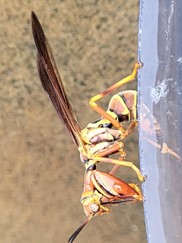Janice James
Amazing! I absolutely have to share this with you!
As I was emptying the plant pot trays this morning I veered around a brown wasp clinging to one rim. It looked intimidating. Then I looked again. It looked …really odd.
I took a couple of photos – thank goodness – and determined it was a Brown Wasp Mantidfly (Climaciella brunnea) which I mentally filed under ‘cool!’ and kept doing my yard chores. When I came in and was explaining how I found this crazy insect to my husband, I decided I needed to look it up.
Wow…. listen to this! – it is not only odd – it is completely bizarre!
So, according to a University of Wisconsin web-site, Climaciella brunnea, or the Wasp Mantidfly is widespread in North America, ranging from Costa Rica to southern Canada. It is one of 13 species on this continent that falls within the Family Mantispidae (Mantisflies/mantidflies) which is within the Order Neuroptera (‘nerve wings’) which is the group including antlions, lacewings, and even owlflies. Neuropterans have four, veined, about equi-sized wings, large eyes, and long antennae, with biting and chewing mouthparts, like grasshoppers. As flyers, they’re not the most athletic group, being a bit clumsy. They undergo complete metamorphosis (egg-larvae-pupa-adult). Adults feed on nectar and/or other insects, but larvae are carnivorous.
Mantidflies are not related to Praying Mantises, nor to Flies or even Wasps.
And this is where it goes way off the rails… so dust off your science vocabulary…
Ever heard of Batesian mimicry?
Batesian Mimicry is when one species evolves to look like another that is toxic or dangerous – as in the Queen and the Monarch butterflies. This insect has it in spades: to me, it looks very similar to a paper wasp; enough so that I tentatively poked it to get it off my pot rim. Entomologist Eric Eaton is quoted online as saying: “In the case of C. brunnea, the body form has been further modified to look like a paper wasp. The resemblance is uncanny. The base of the abdomen is constricted into a ‘wasp waist’, and the wings are rotated such that they fold over the back instead of pitched ‘roof-like’ as in other mantispids. Even more amazing, the leading edge of each wing is darkened, to resemble the longitudinal fold in the wings of vespid wasps. When startled the Wasp Mantid even splays its wings like an agitated paper wasp.” (www.uwm.edu/field-station/wasp-mantidfly/)
Furthermore, one might think this intense mimicry could cause problems come time for reproduction… but no – the male Mantidfly emits a strong pheromonal signal detectable over as much as three miles, that the females seek out, and will apparently sometimes aggregate around (aggregation pheromones). Eggs, as many as 3000, are laid on low vegetation.
Larvae undergo ‘hypermetamorphosis’ which is a form of metamorphosis in which the larvae emerge as long-legged, agile, super-larvae (!!!) which then search for a wolf spider or other ground dwelling spider. They attach themselves to the spider and hitch a ride along, (known as phoresy) sometimes chewing on the spider if it needs a little sustenance. If it has landed on a male spider it will transfer to a female when the male mates with her (What a STD!). The real prize for the larvae comes when the female spider lays her eggs: the mantidfly larvae slips inside while the spider is spinning her egg case, and, once sealed inside, devours the eggs, becoming more grub-like in later instars until pupating inside the egg case and emerging as an adult. So this insect is ultimately a spider parasite!
Whew. Is that not absolutely crazy?!!! How very convoluted!
Just another reminder that there is a lot out there to learn, every single day.
(www.uwm.edu/field-station/wasp-mantidfly/) The Bug Lady has an absolutely excellent article, with lots of links to photos. Check it out!




